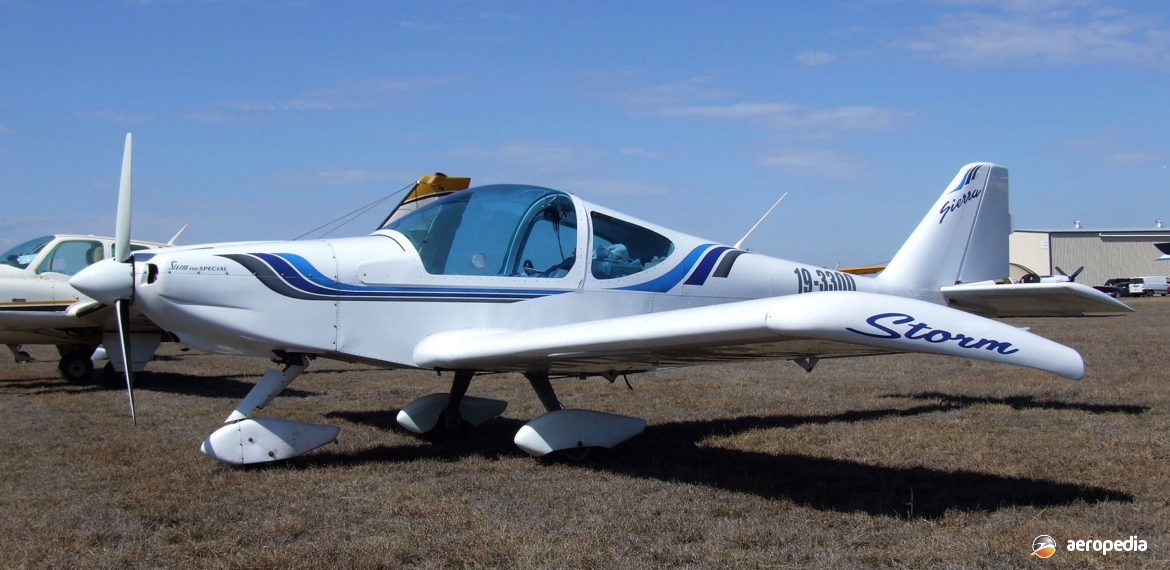Photograph:
S G Aviation Storm 300SP 19-3300 (c/n AUS-007) at Watts Bridge, QLD in August 2006 (David C Eyre)
Country of origin:
Italy
Description:
Two-seat light touring and training aircraft
Power Plant:
(300)
One 86 kw (100 kw) Rotax 912ULS2 turbocharged four-cylinder horizontally-opposed air-and-liquid-cooled engine
Specifications:
- Wingspan: 7.8 m (25 ft 6 in)
- Length: 6.7 m (22 ft)
- Wing area: 9.98 m² (107.4 sq ft)
- Max speed: 282 km/h (175 mph)
- Cruising speed at 75% power: 265 km/h (165 mph)
- Stalling speed in landing configuration: 52 km/h (32 mph)
- Rate of climb: 366 m/min (1,200 ft/min)
- Service ceiling: (12,000 ft)
- Range: 1,300 km (810 miles)
- Fuel capacity: 85 litres (31.6 Imp gals)
- Take-off run: 120 m (395 ft)
- Landing run: 180 m (590 ft)
- Empty weight: 293 kg (644 lb)
- Loaded weight: 570 kg (1,254 lb)
History:
The Storm was one of a series of light aircraft designed by Giovanni Salsedo and built by SG Aviation at Sabaudia in Italy. One design was the Sea Storm, a two or four-seat amphibian with a Rotax 912 engine, whereas the other models were all landplanes which basically varied from each other in the type of power plant installed. All were produced in kit form. Models available included the 280E with a 60 kw (80 hp) Rotax 912 or 75 kw (100 hp) Continental O-200 engine and the 300 Special with an 86 kw (115 hp) Rotax 914 engine or the MidWest AE110 rotary engine.
Further models have included the Century, a two-seat variant with a large baggage compartment, a forward opening hinged canopy, and fuel in two wing tanks. This model was available with either tricycle or tailwheel undercarriage and complied with US Sport and Experimental Aircraft Regulationss. Power plant ws the Rotax 912ULS2. The Storm RG was a variant of the series seating two and of similar configuration to the others but with a retractable tricycle undercarriage, was available in kit form or ready-to-fly form, and could be fitted with either the Rotax 912ULS2 or the turbocharged Rotax 914UL2 engine.
The basic fuselage structure was a conventional riveted box with strengthening longerons and bulkhead, to which the rear decking was added, along with the cockpit. The wings were non-detachable, their structure centred around a main spar constructed as an aluminium sandwich and tapering in thickness towards the wingtip, and a subsidiary rear spar, the two being linked by alloy ribs to make up a box. Three stage, manually-operated, flaps were installed. Tricycle or tailwheel undercarriages could be fitted. Accommodation was provided for two, side-by-side, with dual controls under a single-piece canopy hinged upwards and forwards.
First of the type seen in this region was ZK-VEE (c/n NZ-004), a Storm 300, registered in Hamilton, NZ. A number of examples have been registered in Australia under Recreation Aviation Australia (RAA) regulations, including 19-3300 (c/n AUS-007).

